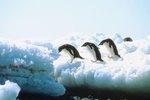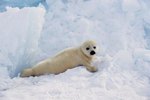
While there's no one species called the Arctic seal, six seal species live in the Arctic region: ribbon seals, ringed seals, harp seals, bearded seals, hooded seals and spotted seals. They have more threats from predators -- including humans -- and pollution than their Antarctic cousins.
What They Look Like
All Arctic seals have the same basic body shape -- large and squat, tapering down to hind flippers at the back, and with two fore flippers -- but they have visible differences. Ribbon seals are brown or black with four ribbons of white running across their bodies, though these markings are more distinctive on males. Spotted seals are silver-gray, with irregular dark spots. Bearded seals are solid colored light gray to dark brown. Harp seals are light gray with black faces and black horseshoe shapes on their backs. Ringed seals can vary in coloring but are usually gray-back with black spots that are circled by white rings. Hooded seals are silver or light gray, with black spots or patches.
How Big They Are
Arctic seals range in size depending on their species. The smallest of them all are ringed seals which are 4 to 4 1/2 feet long, on average, and weigh between 110 and 150 pounds. By contrast, hooded seals are the largest found in the Arctic region, measuring between roughly 8 and 10 feet long and weighing in at up to 880 pounds. Spotted, ribbon and harp seals are on the smaller end of the spectrum, with maximum weights of 250 pounds, 175 pounds and 400 pounds, respectively. Bearded seals are larger, with a maximum weight of almost 800 pounds.
What They Eat
Arctic seals are swift and graceful swimmers who do all of their hunting in the ocean, so a variety of marine creatures are on the menu. They tend to have quite a generalized diet, hunting for a range of different fish, crustaceans, squid, mollusks and marine invertebrates, depending on what foods are abundant in their area. Overfishing of certain species, such as cod, has reduced the amount of food available for some Arctic seals.
What Threats They Face
Several threats exist for Arctic seals. One of the major ones is predation from species such as polar bears, orcas and sharks. Certain seals have their own adaptations to avoid predation, for instance baby harp seals have white coats to blend in with the snow and male hooded seals have inflatable sacs on their heads they can use to startle potential predators. Of course, humans are also predators and will hunt them for meat and fur. All of these seal species are also at risk from pollution and habitat degradation.
References
Photo Credits
-
Jupiterimages/Photos.com/Getty Images




